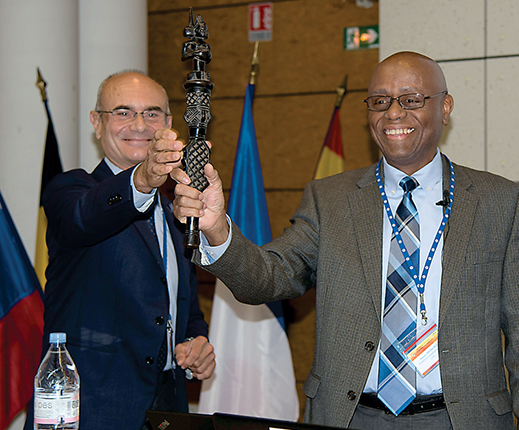Momentum grows for African light source
DOI: 10.1063/PT.3.3050
Nearly 100 scientists gathered in November at the European Synchrotron Radiation Facility (ESRF) in Grenoble, France, for the first conference on realizing an African light source. The delegates came from 13 countries in Africa and 15 in the Americas, Asia, and Europe. Three things emerged from the grassroots effort: A statement that spells out why Africa needs a light source, a roadmap that sets a path for building one, and a steering committee to drive the process.

Francesco Sette (left), director general of the European Synchrotron Radiation Facility, and Sekazi Mtingwa at the inaugural conference for an African light source in November.
CHANTAL ARGOUD/ESRF

A light source can be expected to contribute significantly to the return of the African science diaspora, the training of young scientists, the growth of competitive industries, and the advancement of research to address concerns relevant on the continent, according to the conference’s “Grenoble Resolutions.”
“Nothing besides conventional lasers and computers has revolutionized science like light sources,” says Sekazi Mtingwa, a retired MIT physicist and member of the steering committee. “Countries around the world are racing to build bigger and more intense light sources. Africa needs one to become globally competitive.”
X rays from synchrotron sources are used in many areas of research. Of particular interest for Africa are studies related to diseases such as malaria, AIDS, and Ebola. Paleontology is another area for which Africa is positioned to make scientific contributions. For example, says steering committee chair Simon Connell, a University of Johannesburg physicist, “in South Africa a hominid skull was found. It was sent to ESRF, and they found what is potentially the first ever paleo brain, only because they didn’t need to remove an encrusted rock and chip away at the skull. What synchrotrons have done for studying fossils is amazing.”
The continent’s largest synchrotron user community is in South Africa, which in 2013 became a member of ESRF. Users from other parts of Africa often work abroad. A first step toward realizing an African light source, Connell says, is to find out how many African users there are, which facilities they use, and for what types of research.
The steering committee will also work to train new users, facilitate collaborations with synchrotron users outside of Africa, and build an Africa-funded beamline on an existing light source. “We want to start with mother’s milk,” says Connell, “things that are not controversial.” So discussions about cost, design details, and site will be delayed as long as possible. For now, he says, “it’s more important to train people and progress the science so that it becomes a foregone conclusion that we need a synchrotron.”
The roadmap laid out in Grenoble calls for a non-site-specific design in three years, and a site-specific one in five. Also in five years, agreement should be reached on a business plan and a governance model. CERN—the model for SESAME (Synchrotron-Light for Experimental Science and Applications in the Middle East), which is set to start up this year in Jordan—is regarded as the gold standard for international collaborations.
At that point African governments will need to buy into the project. The development of multibend achromats, which use more magnets to create tighter, brighter x-ray beams, has brought down the size and cost of synchrotrons (see Physics Today, June 2015, page 21
More about the Authors
Toni Feder. tfeder@aip.org





